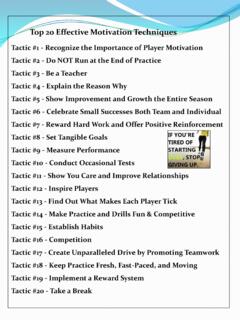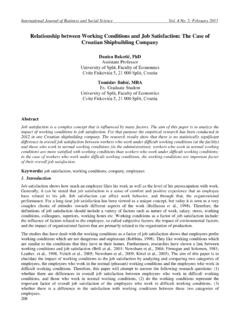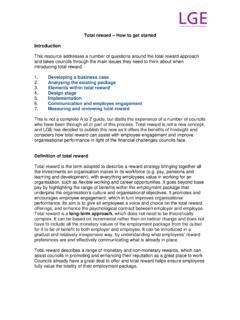Transcription of Motivation through the Design of Work: Test of a Theory
1 ORGANIZATIONAL BEHAVIOR AND HUMAN PERFORMANCE 16, 250-279 (1976) Motivation through the Design of Work: Test of a Theory ]. RICHARD HACKMAN Yale University AND GREC R. OLDHAM University of lllinois A model is proposed that specifies the conditions under which individuals will become internally motivated to perform effectively on their jobs. The model focuses on the interaction among three classes of variables: (a) the psychological states of employees that must be present for internally moti- vated work behavior to develop; (b) the characteristics of jobs that can create these psychological states; and (c) the attributes of individuals that determine how positively a person will respond to a complex and challenging job.
2 The model was tested for 658 employees who work on 62 different jobs in seven organizations, and results support its validity. A number of special features of the model are discussed (including its use as a basis for the diagnosis of jobs and the evaluation of job redesign projects), and the model is compared to other theories of job Design . Work redesign is becoming increasingly prominent as a strategy for attempting to improve simultaneously the productivity and the quality of the work experience of employees in contemporary organizations.
3 Al- though the benefits of work redesign (or "job enrichment" or "job en- largement") are widely touted in the management literature, in fact little is known about the reasons why "enriched" work sometimes leads to posi- tive outcomes for workers and for their employing organizations. Even less is known about the relative effectiveness of various strategies for carrying out the redesign of work (Hackman, 1975). One reason for this state of affairs is that existing theories of work The authors express great appreciation to members of the consulting firm that helped us gain access to the organizations where this research was conducted; to Kenneth Brousseau, Daniel Feldman, and Linda Frank for assistance in data collection and analysis; and to Gerrit Wolf for help in analytic planning.
4 This report was prepared in connection with research supported by the Office of Naval Research (Organizational Effectiveness Research Program, Contract No. N00014-67A- 0097-0026, NR 170-744), and by the Manpower Administration, U. S. Department of Labor (Research and Development Grant No. 21-09-74-14). Since grantees conducting research under government sponsorship are encouraged to express their own judgment freely, this report does not necessarily represent the official opinion or policy of the government. 250 Copyright 1976 by Academic Press, Inc.
5 All rights of reproduction in any form reserved. Motivation through Design OF WORK 251 redesign are not fully adequate to meet the problems encountered in their application. Especially troublesome is the paucity of conceptual tools that are directly useful in guiding the implementation and evaluation of work redesign projects. In the paragraphs to follow, we examine several exist- ing theoretical approaches to work redesign, with a special eye toward the measurability of the concepts employed and the action implications of the theorizing (cf.)
6 Porter, Lawler, & Hackman, 1975, Chap. 10). We then propose and report a test of a Theory of work redesign that focuses spe- cifically on how the characteristics of jobs and the characteristics of people interact to determine when an "enriched" job will lead to beneficial out- comes, and when it will not. Theoretical Approaches to Work Redesign Motivation -hygiene Theory . By far the most influential Theory relevant to work redesign has been the Herzberg two-factor Theory of satisfaction and Motivation (Herzberg, Mausner, & Snyderman, 1959; Herzberg, 1966).
7 In essence, the Theory proposes that the primary determinants of employee satisfaction are factors intrinsic to the work that is done ( , recognition, achievement, responsibility, advancement, personal growth in competence). These factors are called "motivators" because they are believed to be effective in motivating employees to superior effort and performance. Dissatisfaction, on the other hand, is seen as being caused by "hygiene factors" that are extrinsic to the work itself. Examples in- clude company policies, supervisory practices, pay plans, working condi- tions, and so on.
8 The Herzberg Theory specifies that a job will enhance work Motivation and satisfaction only to the degree that "motivators" are designed into the work itself. Changes that deal solely with "hygiene" factors should not lead to increases in employee Motivation . It is to the credit of the Herzberg Theory that it has prompted a great deal of research, and inspired several successful change projects involv- ing the redesign of work ( , Ford, 1969; Paul, Robertson, & Herzberg, 1969). Yet there are difficulties with the Theory that to some extent com- promise its usefulness.
9 For one, a number of researchers have been unable to provide empirical support for the major tenets of the two-factor Theory itself (see, for exam- ple, Dunnette, Campbell, & Hakel, 1967; Hinton, 1968; King, 1970. For analyses favorable to the Theory , see Herzberg, 1966; Whitsett & Winslow, 1967). It appears that the original dichotomization of aspects of the work-place into "motivators" and "hygiene factors" may have been largely a function of methodological artifact, and the present conceptual status of the Theory must be considered highly uncertain.
10 Moreover, the Theory does not provide for differences among people in how responsive they are likely to be to "enriched" jobs. In the AT&T 252 HACKMAN AND OLDHAM studies based on the Theory (Ford, 1969), for example, it was assumed that the motivating factors potentially could increase the work Motivation of all employees. Yet it now appears that some individuals are much more likely to respond positively to an enriched, complex job than are others (Hulin, 1971). The Theory provides no help in determining how such indi- vidual differences phenomena should be dealt with, either at the concep- tual level or in the actual applications.


















